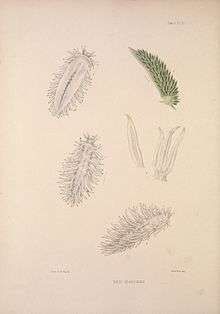Calma glaucoides
Calma glaucoides is a species of marine nudibranch in the family Calmidae. The holotype was described by Alder & Hancock in 1854 from Herm in the Channel Islands, but the nudibranch has since been detected in other parts of the British Isles. It was originally given the name Eolis glaucoides but has since been transferred to the genus Calma.[1] It is an egg predator, feeding on the eggs of fish and cephalopods.
| Calma glaucoides | |
|---|---|
 | |
| Scientific classification | |
| Kingdom: | Animalia |
| Phylum: | Mollusca |
| Class: | Gastropoda |
| Subclass: | Heterobranchia |
| Order: | Nudibranchia |
| Infraorder: | Cladobranchia |
| Superfamily: | Fionoidea |
| Family: | Calmidae |
| Genus: | Calma |
| Species: | C. glaucoides |
| Binomial name | |
| Calma glaucoides (Alder & Hancock, 1854)[1] | |
| Synonyms[1] | |
| |
Description
Calma glaucoides grows to a length of about 12 mm (0.5 in). The body is white and translucent; the head is small, the oral tentacles are small and smooth, and the branchial process is almost linear, being white fringed with yellow. The central part of the body is depressed and the central gland is a brownish colour. The cerata are arranged in eleven clusters, each sharing a common pedicle.[2]
Distribution and habitat
Native to the northeastern Atlantic Ocean, C. glaucoides is found on the coasts of the British Isles, the Channel Islands, France and Spain. It occurs in the littoral zone on rocky coasts, under stones and boulders, and often in association with hydroids.[1][2]
Ecology
Nudibranchs are hermaphrodite, and two individuals mate and transfer spermatophores to each other. The eggs are laid in a ribbon-like gelatinous coil and attached to the substrate.[3] All nudibranchs are carnivorous, and Calma glaucoides specifically is an egg predator. Its small size and creamy white colour provides camouflage while it is feeding on the pale-coloured eggs of teleost fish and cephalopods. Examination of the gut contents shows that this species sometimes consumes its own juveniles. So rich and nourishing is its diet that the gut does not have an anal opening, presumably because the food produces so little residue;[4] however, the larval stage does have an anus.[5]
References
- Gofas, Serge (2019). "Calma glaucoides (Alder & Hancock, 1854)". WoRMS. World Register of Marine Species. Retrieved 27 April 2019.
- Chambers, Paul (2008). Channel Island Marine Molluscs: An Illustrated Guide to the Seashells of Jersey, Guernsey, Alderney, Sark and Herm. Paul Chambers. p. 192. ISBN 978-0-9560655-0-6.
- Ruppert, Edward E.; Fox, Richard, S.; Barnes, Robert D. (2004). Invertebrate Zoology, 7th edition. Cengage Learning. p. 335. ISBN 978-81-315-0104-7.
- "Calma glaucoides". Australian Museum. 2010. Archived from the original on March 13, 2016. Retrieved May 27, 2019.
- Walls, Jerry G. (1982). Encyclopedia of Marine Invertebrates. TFH Publications. p. 410. ISBN 978-0-86622-141-2.